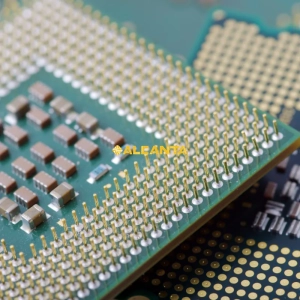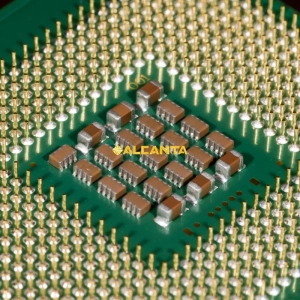Beyond the Chip: Advanced Technologies in Semiconductor Packaging
Semiconductor packaging serves as the pivotal bridge between the tiny, delicate semiconductor components and the robust, user-friendly electronic devices that have become an integral part of our daily lives. At its core, semiconductor packaging involves enclosing semiconductor chips in protective casings, ensuring durability, thermal management, and connectivity. The significance of semiconductor packaging in the electronics industry cannot be overstated. It transforms intricate silicon chips into functional products, enhancing their reliability and performance. This process is not merely a technical necessity but a critical enabler of innovation and progress in electronic devices. As technology advances, the demand for smaller, faster, and more powerful devices grows, underscoring the paramount role of semiconductor packaging in shaping the future landscape of electronics.
chip packaging
ic package
ceramic substrates
pcb substrate
QFN Package
qfn package
PLCC Packages
Semiconductor Packaging Types
Traditional Semiconductor Packages
1. Overview of Traditional Packages
Traditional semiconductor packages have been the backbone of the industry, encompassing various types designed for specific applications. Common packages include Dual In-Line Package (DIP), Quad Flat Package (QFP), and Plastic Leaded Chip Carrier (PLCC). These packages offer a balance between cost-effectiveness, ease of manufacturing, and widespread applicability.
2. Common Types and Applications
- Dual In-Line Package (DIP): Widely used for early integrated circuits, DIP packages feature two parallel rows of pins for easy through-hole mounting. They find applications in consumer electronics and industrial controls.
- Quad Flat Package (QFP): With a flat surface for increased pin density, QFPs are suitable for microcontrollers and microprocessors in various electronic devices.
- Plastic Leaded Chip Carrier (PLCC): Compact and versatile, PLCC packages are prevalent in telecommunications and automotive applications.
Advanced Packaging Techniques
1. Introduction to Advanced Packaging
Advanced packaging techniques represent a paradigm shift in semiconductor packaging, aiming to enhance performance, reduce form factors, and increase functionality. Examples include System-in-Package (SiP), 3D packaging, and Fan-Out Wafer-Level Packaging (FOWLP).
2. Benefits and Innovations
Miniaturization and Integration: Advanced packaging allows for the integration of diverse functions into a compact space, facilitating the development of smaller and more powerful electronic devices.
Enhanced Performance:3D packaging enables the stacking of multiple dies, reducing interconnect lengths and enhancing data transfer rates, leading to improved overall system performance.
Improved Thermal Management: Innovative packaging technologies contribute to better thermal dissipation, addressing challenges associated with the increasing power density of modern semiconductor devices.
Understanding the characteristics and applications of both traditional and advanced packaging types is crucial for navigating the dynamic landscape of semiconductor technologies.
Semiconductor Packaging Materials
Materials Used in Packaging
Semiconductor packaging relies on a variety of materials carefully selected to meet stringent requirements for electrical, thermal, and mechanical properties. Common materials include:
1. Substrates
- Organic Substrates: Materials like FR-4 and polyimide are commonly used for their cost-effectiveness and ease of manufacturing.
- Inorganic Substrates: Ceramics and metal-core substrates offer superior thermal conductivity, making them suitable for high-power applications.
2. Encapsulation Materials
- Epoxy Molding Compounds (EMC): These thermosetting resins protect semiconductor devices from environmental factors, providing mechanical support and insulation.
- Molded Underfill (MUF): Applied beneath the chip, MUF enhances mechanical strength and reliability by reducing stress during temperature cycling.
3. Conductive Materials
- Solder: Commonly used for interconnecting components, solder materials such as lead-free solders and solder pastes ensure reliable electrical connections.
- Copper and Aluminum: These materials are used for interconnects and lead frames due to their excellent conductivity.
Evolution of Packaging Materials
The semiconductor industry has witnessed a continuous evolution in packaging materials, driven by the need for improved performance, miniaturization, and environmental considerations.
1. Transition to Lead-Free Materials
- In response to environmental concerns, the industry has shifted from lead-containing solders to lead-free alternatives, promoting sustainability.
2. Emergence of Advanced Substrates
- Advanced substrates, including embedded silicon substrates and build-up substrates, are gaining prominence to address the demands of high-density interconnects in advanced packaging.
3. Flexible and Organic Electronics
- As consumer electronics demand flexibility and lightweight designs, there’s a growing interest in flexible and organic materials, such as flexible substrates and organic conductors.
Impact on Performance and Reliability
The choice of packaging materials significantly influences the overall performance and reliability of semiconductor devices.
1. Thermal Management
- High thermal conductivity materials contribute to efficient heat dissipation, ensuring the semiconductor devices operate within temperature limits.
2. Electrical Performance
- The electrical properties of materials impact signal integrity and transmission, directly influencing the speed and reliability of electronic devices.
3. Reliability and Durability
- Robust packaging materials contribute to the long-term reliability and durability of semiconductor devices, especially in demanding applications such as automotive and aerospace.
Semiconductor Packaging Process
Step-by-step Process Overview
The semiconductor packaging process is a meticulous series of steps crucial for transforming bare semiconductor devices into functional, reliable components for electronic systems.
Die Preparation
- The process begins with the preparation of individual semiconductor dies, which involves testing and sorting to ensure only functional dies proceed to the packaging stage.
Wire Bonding or Flip-Chip Assembly
- In wire bonding, thin wires are attached to the semiconductor die and the package substrate. Alternatively, flip-chip assembly involves directly attaching the chip to the substrate, enhancing electrical performance.
Encapsulation
- The semiconductor die is encapsulated using materials like epoxy molding compounds (EMC) to protect it from environmental factors and provide mechanical support.
Lead Frame Attachment
- The lead frame, a metal structure supporting the semiconductor device, is attached to the package substrate, forming the basis for external connections.
Molding and Curing
- The encapsulated package undergoes molding to achieve its final shape. The molding compound is then cured, ensuring structural integrity.
Testing
- Rigorous testing is conducted to verify the functionality, electrical characteristics, and reliability of the packaged semiconductor device.
Marking and Final Inspection
- The final package is marked with essential information, and a thorough inspection is performed to ensure compliance with quality standards.
Key Stages and Technologies Involved
Advanced Interconnect Technologies
- Technologies like copper wire bonding and copper pillar flip-chip enable high-density interconnects, enhancing electrical performance and allowing for miniaturization.
3D Packaging
- Three-dimensional packaging involves stacking multiple dies on top of each other, reducing interconnect lengths and improving data transfer rates.
Wafer-Level Packaging (WLP)
- WLP enables packaging at the wafer level before the individual dies are separated, increasing production efficiency and lowering costs.
System-in-Package (SiP)
- SiP integrates multiple components, such as logic, memory, and sensors, into a single package, enhancing overall system performance and reducing the footprint.
Challenges and Solutions in Packaging Process
Miniaturization Challenges
- As electronic devices shrink in size, the packaging process faces challenges in maintaining precision and reliability. Advanced packaging techniques, like System-in-Package, address this by consolidating functions in a smaller space.
Thermal Management
- Increasing power densities demand efficient thermal management. Advanced materials with superior thermal conductivity and innovative cooling solutions are employed to address thermal challenges.
Reliability Concerns
- The packaging process must ensure long-term reliability, especially in critical applications like automotive and aerospace. Rigorous testing methodologies and robust materials contribute to meeting reliability standards.
Cost Efficiency
- Advanced packaging technologies may initially present higher costs. However, ongoing research and development aim to optimize processes and materials, striking a balance between performance and cost-effectiveness.
IC Packaging (Integrated Circuit Packaging) – Enhancing Semiconductor Packaging Efficiency
Integrated Circuit (IC) packaging is a critical aspect of Semiconductor Packaging, involving the encapsulation of microelectronic devices for protection, connectivity, and performance optimization. The significance lies in shielding delicate ICs from external factors, providing electrical connections, and ensuring reliability within electronic systems.
Types of IC Packaging
Dual In-Line Package (DIP)
- DIP packaging, a traditional form, features two parallel rows of pins for through-hole mounting. It has been widely used for decades in various applications.
Surface Mount Device (SMD)
- SMD packaging involves mounting components directly onto the surface of a printed circuit board (PCB), reducing the overall size and enabling automated assembly.
Ball Grid Array (BGA)
- BGA packages use an array of solder balls beneath the IC, enhancing thermal performance and electrical connectivity. This type is common in high-performance applications.
Chip-on-Board (COB)
- COB involves directly mounting the IC on the PCB, eliminating the traditional package. This approach reduces size, enhances thermal dissipation, and is prevalent in compact electronic devices.
System-in-Package (SiP)
- SiP is a more advanced form, incorporating multiple ICs into a single package. It fosters integration, reducing the footprint and improving overall system performance.
Role in Ensuring IC Performance and Reliability
Electrical Integrity
- IC packaging plays a crucial role in maintaining electrical integrity by providing the necessary interconnections. High-quality packaging materials and techniques ensure minimal signal loss and optimal electrical performance.
Thermal Management
- Efficient thermal dissipation is essential for ICs, especially in high-performance applications. Packaging solutions like BGA facilitate improved heat transfer, preventing overheating and ensuring long-term reliability.
Protection from External Factors
- IC packaging shields the delicate semiconductor components from environmental factors such as moisture, dust, and physical damage. This protection is vital for ensuring the longevity and reliability of the integrated circuits.
Miniaturization and Integration
- IC packaging contributes to the ongoing trend of miniaturization by providing compact solutions like SiP. The integration of multiple functions into a single package enhances efficiency and reduces the overall size of electronic devices.
Reliability Testing
- Rigorous testing during the IC packaging process ensures that only reliable components make it to the final product. This includes functional testing, thermal cycling, and other assessments to guarantee the durability and performance of the packaged ICs.
FAQs About Semiconductor Packaging
What is semiconductor packaging?
Semiconductor packaging refers to the process of enclosing semiconductor devices, such as integrated circuits (ICs), in protective and functional casings. This packaging is crucial for safeguarding the delicate semiconductor components from environmental factors, providing electrical connections, and facilitating integration into electronic systems.
What is advanced packaging in the semiconductor industry?
Advanced packaging in the semiconductor industry involves innovative techniques and technologies that go beyond traditional methods to enhance the performance, reliability, and efficiency of semiconductor devices. This can include 3D packaging, System-in-Package (SiP), and other cutting-edge approaches that contribute to miniaturization, improved thermal management, and overall system integration.
What are the traditional semiconductor packages?
Traditional semiconductor packages include various forms that have been widely used in the industry. Some examples are:
- Dual In-Line Package (DIP): Two parallel rows of pins for through-hole mounting.
- Quad Flat Package (QFP): Flat surface with pins on all four sides, suitable for microcontrollers and microprocessors.
- Plastic Leaded Chip Carrier (PLCC): Compact and versatile package, commonly used in telecommunications and automotive applications.
What is a semiconductor packaging engineer?
A semiconductor packaging engineer is a professional responsible for designing, developing, and implementing packaging solutions for semiconductor devices. Their role involves selecting appropriate materials, optimizing package designs for performance and reliability, and addressing challenges related to thermal management, electrical connectivity, and environmental protection. Semiconductor packaging engineers play a crucial role in ensuring the successful integration of semiconductor devices into electronic systems.
What is IC packaging?
IC packaging, or Integrated Circuit packaging, involves enclosing an integrated circuit (IC) in a protective and functional casing. This process includes providing electrical connections, ensuring thermal management, and protecting the IC from external factors. IC packaging is a crucial step in the semiconductor manufacturing process, contributing to the overall performance, reliability, and longevity of electronic devices.







